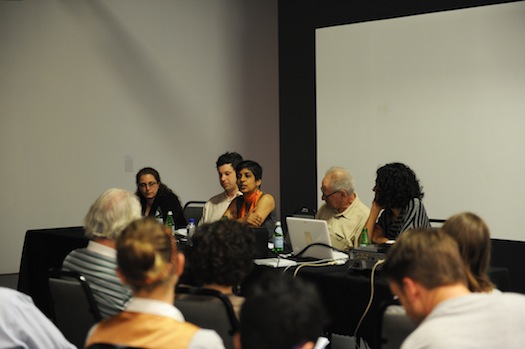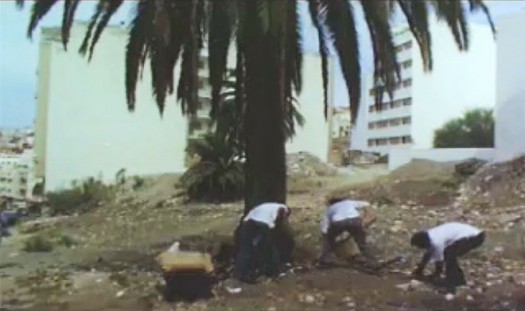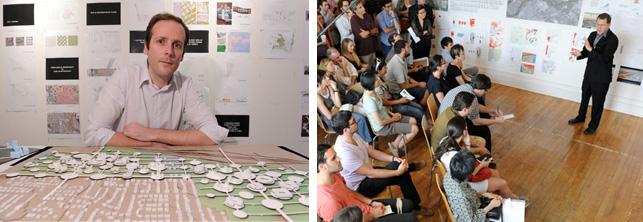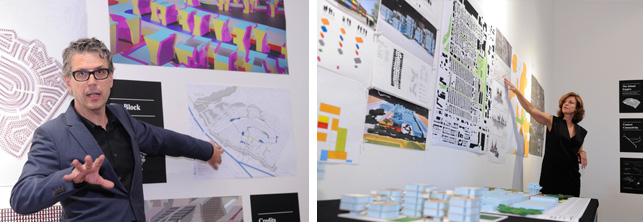
We are celebrating 15 years — and counting — of stories that are deeply researched and deeply felt, that build a historical record of what the city has been.
We are celebrating 15 years — and counting — of stories that are deeply researched and deeply felt, that build a historical record of what the city has been.
About four years ago, a latent pattern of unethical, self-interested and surreptitious decision-making reared its head to wreak havoc in the American housing market. Americans were living on a dream buoyed by false hope: we thought we could have it all. But as millions defaulted on mortgages with unmanageable interest rates, made on credit they couldn’t afford to pay off, the country was exposed to the networks of mistrust and corruption that came to define the zeitgeist of today’s financial system.
Now, architects, artists, planners and leaders of arts institutions are working to articulate why so many people lost, and are continuing to lose, their homes, and what opportunities for aid were lost or ignored as the country sank into a recession. To say the financial crisis is not at its root a problem for architects is to overlook the inherent ties between success, investment and dwelling that define a national identity.
In an effort to harness the ideas of the creative community to provoke change, the Whitney Independent Study Program and the Museum of Modern Art (MoMA) have embarked on curatorial projects that deconstruct “foreclosure” in markedly different ways. Essentially, both ask for a new, creative perspective on how to fill the vacant, unused and struggling spaces produced by the financial crisis.

Photograph of public program City as Stage, in conjunction with the exhibition Foreclosed: Between Crisis and Possibility, The Kitchen, NYC, 11 June 2011 | © Maria Rapicavoli
FORECLOSED: BETWEEN CRISIS AND POSSIBILITY
In Foreclosed: Between Crisis and Possibility, a group exhibition and series of public programs curated by Whitney Independent Study Program (ISP) Curatorial Fellows Jennifer Burris, Sofía Olascoaga, Sadia Shirazi and Gaia Tedone, “between” is the operative word. Well, that and “foreclosed.” Using foreclosure mainly as a point of departure, the show and discussions posit multiple approaches to looking at and utilizing the forgotten spaces that embody the aftershocks of a declining economy and ask how artists, architects and planners grapple with a culture of crisis.
“City as Stage,” a conversation between GSAPP Professor Emeritus and planner Peter Marcuse, urban planner/architect/artist Damon Rich, Director and Chief Curator of the Sheila C. Johnson Design Center Radhika Subramaniam and artist Tania Bruguera, moderated by Sadia Shirazi, was held at The Kitchen on June 11th. The afternoon began with a screening of Beau Geste by Yto Barrada. In Beau Geste, Barrada patches a malignant hole in a palm tree in a vacant lot in Tangier, trying to thwart a developer who gouged it in hopes of killing the tree, thus allowing him to build up the lot. This guerilla-style urban intervention set the tone for the ensuing discussion on several levels: the scale was small, the action direct, and its consequence indeterminate.

Yto Barrada, still from Beau Geste, 2009. 16mm film transferred to digital video, color, sound; 3 min | Courtesy of Galerie Sfeir-Semler, Hamburg and Beirut, and Galerie Polaris, Paris
The crucial question facing the arts community, the panel seemed to agree, is: what actions can artists or arts organizations take to resist the consequences of foreclosure and fight the momentum of their underlying causes by empowering marginalized populations and interrogating systems of power? “It is easier to see the consequences than the causes of foreclosure,” Marcuse observed. He went on to say that the globalization of capital and a crisis of taxation have led to increased segregation, polarization and reallocation of urban space internationally.
Radhika Subramaniam discussed the challenges of engaging with catastrophe in the urban landscape. Ground Zero, she offered, is a site perceived as uniquely American, even uniquely New York. Visiting a memorial at that site is an experience of specific remembrance, not necessarily of reflection on tragedy more generally. Neighbors in Lower Manhattan, Subramaniam recalled, thought it would be inappropriate to include a memorial to Hurricane Katrina victims at Ground Zero, preventing a larger conversation about a shared vulnerability. As the urban landscape changes, physical sites become locations of selective remembering, or of selective amnesia. By locating art performances in these spaces and purposefully soliciting the narratives of affected communities, she suggested, we will come to a better understanding of what is being lost and what can be produced to take its place.
Tania Bruguera, an anchor of both the discussion and exhibition, dissected the ways that artistic practice can team with cultural institutions to bring agency to individuals. Bruguera, whose project Immigrant Movement International is sponsored by Creative Time and the Queens Museum of Art (QMA) in conjunction with the exhibition, emphasized the importance of “arte util” — art that is useful. Util in Spanish translates into both useful and tool, Bruguera noted, and for art to be useful one needs to work with the correct tools: in this context, knowledge of politics and the ability to communicate with politicians. Bruguera encouraged audience members to form counter organizations in opposition to existing government bodies and to align with politicians to reverse the aggressive attitude many officials have towards activist art groups. The purpose of these counter organizations was unclear — would they serve as protests in and of themselves or establish themselves to provide services? Tania’s description of the outcome of her own project in Queens had an equally indeterminate direction — is the art the action itself or is it what that action produces?
Other panelists’ opinions on this topic, it became apparent, were mixed. Damon Rich agreed that in order to effect change one needs to be able to “talk the talk and walk the walk.” But gestures, which Subramaniam defined as “small actions of imagination that get lodged in your shoe and build up over time,” Rich felt to be an ineffectual romanticism. Coalition building, in Rich’s experience, is the surest way to guarantee change, and arts institutions, he argued, should become the nexuses around which activists and communities can converge. Returning to the Queens Museum of Art, Rich noted that it is the only museum he has worked with that has a community organizer as a defined staff position. For Red Lines Housing Crisis Learning Center, the QMA 2009 exhibition of Rich’s work, he worked with the community organizer to engage housing advocacy groups, elected officials and a range of advocates in Queens neighborhoods affected by the foreclosure crisis to make the show both informative and useful.

Sam Dufaux of WORKac (left) and Michael Bell of Visible Weather (right) | Photograph by Don Pollard via The Museum of Modern Art Inside/Out blog.
FORECLOSED: REHOUSING THE AMERICAN DREAM
Reinhold Martin and Barry Bergdoll, curators of MoMA’s forthcoming exhibition Foreclosed: Rehousing the American Dream, hosted the first in a series of open studios at PS1 on June 18th. Participating teams pinned up the early stages of proposed architectural interventions in “megaregions” — metropolitan areas that lies within a corridor between two major cities – that have been dramatically affected by foreclosure. Where the Whitney ISP/Kitchen exhibition and discussion aimed to be open-ended, so as to allow for interdisciplinary connections at all scales, MoMA grounded itself in real sites where architecture as a specific discipline can alter an environment and thus change the course of an economic downward spiral. The exhibition, as the title suggests, will interrogate and, one hopes, reframe the “American Dream” that has shaped our flawed housing policies and design preferences. It remains to be seen if the plans imagined by assembled firms will go farther than MoMA’s walls, but the show has the potential to popularize innovative and economically sustainable design themes.
Responding to ideas in the soon-to-be-published Buell Hypothesis (a screenplay style research publication from the Temple Hoyne Buell Center investigating the housing crisis and the American dream), the proposals retrospectively pretend that when the foreclosure crisis hit, the government had turned to architects to help build a solution. Zago Architects, the firm designing new housing for Rialto, California, moved forward from the hypothetical premise that when stimulus money was allocated the Federal government had devoted funds to architects. With this imagined money in mind, the team proposed new typologies that blended the natural botany of the region with biodiverse landscaping in swooping flows of dense housing that create pockets for privacy and play by relaxing coincident boundaries.

Richard Zago and Jeanne Gang | Photograph by Don Pollard via The Museum of Modern Art Inside/Out blog.
Perhaps MoMA’s exhibition will spur the administration to think more creatively when doling out cash in the future. As Andrew Zago pointed out, what came before the crash can continue after, and it is imperative to consider how to reuse the investment already made on the ground. However, as the exhibition moves forward and the emerging conversation surrounding foreclosure continues among cultural institutions, the creative minds at work must be cognizant of their objectives: to truly aid those who are losing their homes and to build a new platform on which Americans, and citizens internationally, can construct housing paradigms and approaches to ownership, investment and property.
At “City as Stage,” Damon Rich remarked that often when a cultural phenomenon arises as a popular subject of study in arts institutions, it simply serves to let institutions air grievances about a contemporary topic while business proceeds as usual. Given the grave and wide reaching effects of foreclosure, we should hope this won’t be the case. Instead, as both the Whitney ISP and MoMA shows articulate, we have reached a point of reflection where now scholars, artists and architects can create inventive partnerships that intervene directly to patch cracks through which marginalized people can fall. To do this will require a marriage of agency, responsibility and an inclusive creativity.
The views expressed here are those of the author only and do not reflect the position of Urban Omnibus editorial staff or the Architectural League of New York.
The views expressed here are those of the authors only and do not reflect the position of The Architectural League of New York.